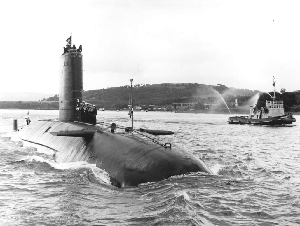HMS Conqueror (S48)

Conqueror returning to the Clyde Submarine base (Faslane) after the Falklands War, 4 July 1982
|
|
| History | |
|---|---|
|
|
|
| Laid down: | 5 December 1967 |
| Launched: | 18 August 1969 |
| Commissioned: | 9 November 1971 |
| Decommissioned: | 2 August 1990 |
| Nickname(s): | "Conks" |
| Honours and awards: |
Falkland Islands, 1982 |
| Status: | At Devonport awaiting dismantling |
| Badge: |  |
| General characteristics | |
| Class and type: | Churchill-class submarine |
| Displacement: | 4,900 tonnes (submerged) |
| Length: | 86.9 m (285 ft) |
| Beam: | 10.1 m (33 ft) |
| Draught: | 8.2 m (27 ft) |
| Propulsion: | One Rolls-Royce PWR nuclear reactor, one shaft |
| Speed: | 28 knots (52 km/h) (submerged) |
| Range: | Limited only by food stored on board |
| Complement: | 103 |
| Armament: |
|
HMS Conqueror (nickname "Conks") was a Churchill-class nuclear-powered fleet submarine that served in the Royal Navy from 1971 to 1990. She was built by Cammell Laird in Birkenhead (the only British nuclear fleet submarine not to be built at Barrow-in-Furness).
She is[update] the only nuclear-powered submarine known to have engaged an enemy ship with torpedoes, sinking the cruiser General Belgrano with two Mark 8 torpedoes during the 1982 Falklands War.
Conqueror was the third submarine of her class, following on from the earlier Churchill and Courageous. The submarines were designed to face the Soviet threat at sea by attacking other ships and submarines, and spying on Soviet nuclear-armed submarine movements.
Conqueror, commanded by Commander Chris Wreford-Brown, was most famously deployed during the Falklands War, setting sail from Faslane Naval Base on the Gare Loch in Scotland on 3 April 1982, one day after the Argentine invasion. Conqueror arrived in the exclusion zone around the Falkland Islands 21 days later and was ordered to scan the area for Argentine shipping, particularly the aircraft carrier Veinticinco de Mayo ("25th of May").
...
Wikipedia
